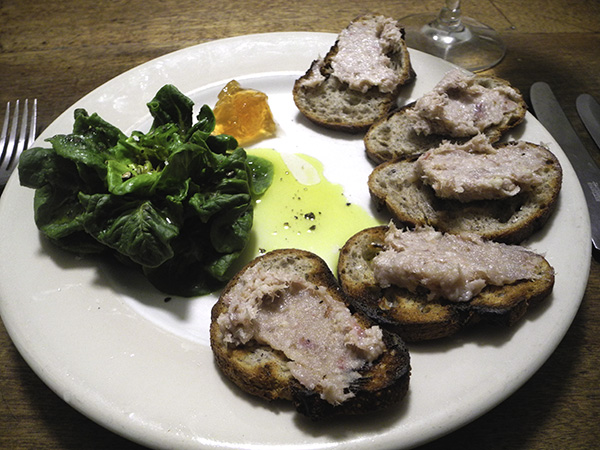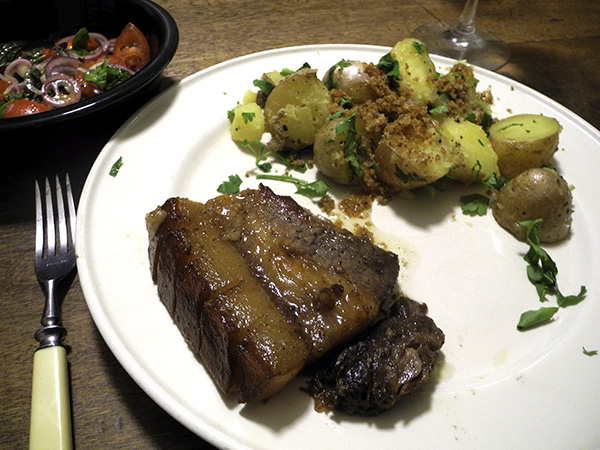
The concept, or description of this meal alone might almost be satisfaction enough for a food enthusiast, if it had not also been really delicious, with all of the unusually long history of its making able to be fully savored in the tasting of it; also, aural satisfaction would assume the listener wasn’t actually hungry to start with.
I was writing above about the main course, but the appetizer was no slouch in any long food preparation contest, except that somebodies else had done the work in its case, and spent the time, before I found their fabulous charcuterie selections in the Union Square Greenmarket.
The meat in the first course, while certainly related to the second in its origins (pork belly!), could not have been more different as served.
- the contents of a small 3-ounce jar of Hudson Vally Charcuterie at Raven & Boar farm Smoked Rillettes/pork belly confit from pastured heritage whey fed pigs spread on toasted slices of a buckwheat baguette from Runner & Stone Bakery
- dabs of a horseradish jelly from Berkshire Berries
- two small heads of Gem lettuce (a sturdy dwarf Romaine) from Tamarack Hollow Farm, their roots snipped off and the leaves pressed down to almost resemble rosettes, dressed with a good olive oil, Badia a Coltibuono, Monti del Chianti from Chelsea Whole Foods Market, Maldon sea salt, freshly ground black pepper, and a bit of plain white vinegar
- the wine with the first course, an amazing, brilliant riesling, was an Australian (Victoria/Great Western) white, Best’s ‘Great Western’ Riesling 2017, made by Best’s Wines, from Astor Wines

I used a Dan Barber recipe to prepare the main course of pork belly, although I had a much smaller piece of meat than he has/had.
I started exactly 4 days before we sat down to dinner
- On Friday night I prepared a spice rub, reducing Barber’s amounts to serve a piece of pork weighing little over a pound (I actually already had all of the ingredients): 2 tablespoon fennel seeds; 2 teaspoons cumin seeds; 1 teaspoon coriander seeds; 1 1/2 teaspoons black peppercorns; 1 small piece of star anise; 1 small piece of cinnamon stick [I think I forgot to add this]; 1/3 teaspoon of white peppercorns; 1 teaspoon of whole cloves; 2 teaspoons of ground coriander; 3 tablespoons of salt; and 3 tablespoons of sugar; I scored the narrow top layer of fat (which was the configuration of the piece I had), rubbed the spices into the meat, and left it covered inside the ‘ice box’ (refrigerator) until Monday morning, when I rinsed the pork belly, placed it inside the perfect size oval enameled cast iron pot that I’ve had for almost 50 years, and then covered it with a liquid composed of just under one cup of a good low-sodium Better Than Bullion chicken base, but adding roughly a third of a cup of an incredibly rich and very complex stock remaining from a January meal of braised smoked pork loin that I had been keeping in the freezer, covered the meat and the liquid with a piece of parchment paper cut to fit, and placed the pot inside a very ‘slow’, 200º oven, not touching it for exactly 7 hours, at which time I removed the pot from the oven, divided the belly into 2 pieces and let it come to room temperature in its liquid before removing it and placing it in the refrigerator until I was ready to heat it inside a small copper skillet with a tablespoon or more of butter, turning once, arranging the pork on 2 plates, not even thinking about adding a garnish, since they were clearly their own adornment
- just under a pound of pinto potatoes from Norwich Meadows Farm in the Union Square Greenmarket, scrubbed, boiled whole and unpeeled in heavily-salted water until barely cooked through, drained, halved, dried in the still-warm large vintage Corning Pyrex Flameware blue-glass pot in which they had cooked, a tablespoons of Organic Valley European-Style Cultured Butter added, seasoned with sea salt and freshly-ground black pepper, arranged on the plates and sprinkled with homemade breadcrumbs that had first been browned in a little butter with a pinch of salt, garnished with chopped parsley from Phillips Farms
- a rather German salad, served in a shallow bowl to the side, composed of 6 quartered Backyard Farms Maine ‘cocktail tomatoes’ from Chelsea Whole Foods Market, tossed with one small sliced red onion from Kellie Quarton’s Quarton Farm, salt, black pepper, 2 tablespoons of olive oil and less than one tablespoon of plain vinegar, plus a mix of herbs (lovage from Two Guys from Woodbridge, spearmint from Stokes Farms, sage and thyme from Phillips Farms), and allowed to sit for 30 minutes before serving
- the wine with the main course was an extraordinary German (Ahr) red, and an extraordinary good pairing with the pork belly, Meyer-Näkel Ahr Spätburgunder Pinot Noir 2014, from Gramercy Wine
- the music throughout the meal was a beautiful recording of only some of Mendelssohn’s wonderful String Symphonies, performed by Concerto Köln